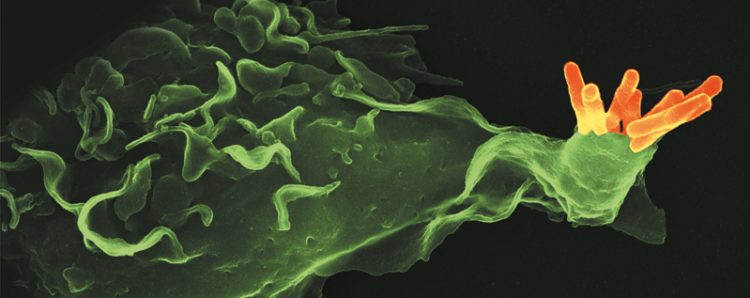Tuberculosis research takes off

The tuberculosis bacterium Mycobacterium tuberculosis. © MPI for Infection Biology / Volker Brinkmann
For 80 years there was essentially a lull in tuberculosis research. Indeed, the last scientific breakthrough in 1921, the Bacillus Calmette-Guérin (BCG) vaccine, still forms the central pillar of tuberculosis prevention.
In most cases, immunisation with BCG protects children from the worst forms of the disease, but not against the most common form, pulmonary tuberculosis in adults and children.
The vaccine has therefore not helped to reduce the number of tuberculosis cases. Only since the start of the new millennium has research once again been able to report significant advances in the development of new vaccines and drugs.
There are now a number of promising vaccine candidates. But setbacks still occur: In 2013 the most advanced candidate proved disappointing in a clinical trial with children and in 2015 in a clinical trial with HIV-positive adults. Although several other candidates have passed preliminary clinical tests, BCG will remain the only available vaccine for some years to come.
At the same time, more and more cases of tuberculosis are occurring that are resistant to all drugs currently available. It therefore appears unlikely that the targets set by the World Health Organization (WHO) will be met, namely to reduce the global incidence of tuberculosis by 90 percent and the mortality rate by 95 percent by 2035. “The relentless rise in the number of tuberculosis cases appears to have been halted for the time being, and the incidence of tuberculosis is on a slow decline for the first time in decades. Nevertheless, we need to do a lot more to effectively contain the disease,” says Stefan Kaufmann, Director at the Max Planck Institute for Infection Biology in Berlin and member of several international research networks.
A major obstacle is the enormous cost of tuberculosis research. Even a phase 2 trial, which aims to evaluate efficacy and safety in a relatively few number of patients, costs about 20 million US dollars to run. A large-scale phase 3 trial costs a whopping 100 million dollars. Above and beyond that, ongoing tuberculosis research requires more than 100 million dollars per year. Yet the research and development costs for tuberculosis vaccines pale in significance compared to the financial burden imposed by the disease. According to a study, tuberculosis-related work incapacity and treatment costs the EU five billion euros every year. “We can only meet this financial challenge if public research organizations, industry, governments and non-governmental organizations join forces. At the same time, we need to do everything possible to make research more efficient,” says Kaufmann.
Together with Thomas G. Evans of Aeras and Willem A. Hanekom of the Bill & Melinda Gates Foundation, Kaufman proposes a number of measures for organising tuberculosis research more effectively in future. For example, it must be ensured that only the most promising vaccine candidates progress into subsequent trials. To this end, research institutes around the world must work closely together to coordinate their trials. For instance, they should define standardised targets for trials, compare vaccine candidates directly with each other in trials and establish exact criteria for measuring the protective effect of a vaccine. “In this way substantial costs could be saved. It would also be helpful to harmonise trials on tuberculosis vaccines with trials on tuberculosis drugs and HIV vaccines,” Kaufmann advises.
Considerable costs could also be saved if a way could be found to reduce the number of participants required for trials. One solution might be to conduct trials with subjects from high-risk groups. Individuals from such groups have a higher-than-average likelihood of becoming infected. Thus, the number of patients needed for informative trials could be recruited more quickly.
In addition, molecular tests such as the interferon gamma assay and the tuberculin skin test, which reliably demonstrate tuberculosis infection, could reduce the scope of trials and save money. Trials that measure the efficacy of vaccine candidates on the basis of such tests need fewer subjects. So-called biomarkers could also help identify those individuals in whom a vaccine is effective.
Moreover, the analysis of interim results of ongoing trials can improve their cost-efficiency. In this way, the trials can be quickly adjusted to take into account any new findings obtained, and the number of participants can be increased or reduced accordingly. “Other researchers should also have access to the data and samples from such trials so that future trials can also benefit from them,” says Kaufmann.
Contact
Prof. Dr. Dr. h. c. Stefan H.E. Kaufmann
Max Planck Institute for Infection Biology, Berlin
Phone: +49 30 28460-500
Fax: +49 30 28460-501
Email: kaufmann@mpiib-berlin.mpg.de
Original publication
Stefan H.E. Kaufmann, Thomas G. Evans, Willem A. Hanekom
Tuberculosis vaccines: Time for a global strategy
Science Translational Medicine, 25. Februar 2015
Media Contact
More Information:
http://www.mpg.de/9066221/tuberculosis-researchAll latest news from the category: Health and Medicine
This subject area encompasses research and studies in the field of human medicine.
Among the wide-ranging list of topics covered here are anesthesiology, anatomy, surgery, human genetics, hygiene and environmental medicine, internal medicine, neurology, pharmacology, physiology, urology and dental medicine.
Newest articles

High-energy-density aqueous battery based on halogen multi-electron transfer
Traditional non-aqueous lithium-ion batteries have a high energy density, but their safety is compromised due to the flammable organic electrolytes they utilize. Aqueous batteries use water as the solvent for…

First-ever combined heart pump and pig kidney transplant
…gives new hope to patient with terminal illness. Surgeons at NYU Langone Health performed the first-ever combined mechanical heart pump and gene-edited pig kidney transplant surgery in a 54-year-old woman…

Biophysics: Testing how well biomarkers work
LMU researchers have developed a method to determine how reliably target proteins can be labeled using super-resolution fluorescence microscopy. Modern microscopy techniques make it possible to examine the inner workings…





















